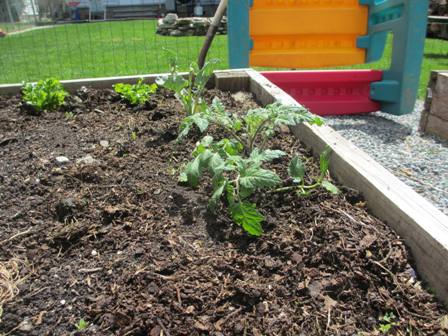Wondering about mulch and how to use it to fertilize and protect your garden plants? Here’s our handy how-to article.
What is mulch and why should I use it in my vegetable garden?
When should I mulch my vegetable garden: spring, fall, or both?
What types of mulch are best for my vegetable garden?
How do I apply mulch to my garden beds?

Q: What is mulch and why should I use it in my vegetable garden?
A: Mulch is a rather broad term. According to this article, mulch is “any type of material that is spread out or laid over the soil as a covering.” The advantages to mulched garden beds are numerous:
Mulched garden beds stay warmer in the frigid winter and cooler through the heat of summer. The mulch acts as a layer of protective insulation in this manner.
Mulch adds nutrients to the soil by slowly breaking down in the same way that the carpet of pine needles and leaves break down on the forest floor. This creates a rich, fertile soil where garden vegetables can thrive easily.
Mulch delivers just the right amount of water to the root system of your plants. The moisture is trapped by and then slowly filters through the layer of mulch, delivering a slow release of water that is ideal for plant growth. Mulched garden plants do not require as much water as non-mulched plants, and experience extra protection from problems like runoff or scorched plants.
Mulched gardens deliver higher yields by increasing the nutrients plants require to thrive and grow, and by cutting down on rot and disease.
Q: When should I mulch my garden beds: spring, fall, or both?
A: As long as you’re using an organic compost mulch that will easily break down and create nutrient-rich soil for your plants to grow, you can add mulch to your garden as often as you like. An application at the end of the fall growing season, and then another one in the spring, is ideal.
To winterize your garden, first you should clear away any old plants that are still growing, as well as remove any debris that may have collected in and around your garden beds. Spread a 2-4 inch layer of mulch over the soil which will act as a blanket to warm the earth during the coldest winter months, and decompose gradually, creating beautiful, rich earth to plant in during springtime.
Ready your garden beds for spring planting by turning in the old mulch that you put down in the fall. Then, add another layer of mulch after you put your plants into the soil and they have become somewhat established.
Q: What types of mulch are best for my vegetable garden?
A: Organic compost is one of the best ways to augment your soil for producing lush, nutrient-rich vegetables. You can either make your own compost using a homemade compost bin or one of those store-bought contraptions; or, you can purchase the compost at your local nursery. Good items to compost: grass clippings, leaf mulch, dead plants, and biodegradable trash from your home such as color-free paper, plant rinds, eggshells, coffee grinds. Avoid using animal products (old meat) in your compost pile, as these are likely to attract vermin.
Avoid purchasing bagged compost from the big-box stores, as it’s less likely to be of good quality and may not really be all that organic.
Organic manure is also excellent for plants. You can find cow, horse, or sheep manure at your local farms. Mix the manure in with your plant soil or add water to the manure to create a “manure tea” that you can water with. Manure requires frequent applications as it breaks down more quickly than plant-based compost.
Leaf mulch is excellent for plants. Be sure to shred the leaves thoroughly. Avoid laying clumps of non-shredded leaves over your garden, as these can mat down and hold moisture, causing mold and fungi to grow. Add a layer of compost over your garden soil in the winter, and top with another layer of leaf mulch. In spring, these can be turned into the soil for a rich humus.
Hay or straw works great as a ground cover during planting season. This type of material wicks moisture away from the lower-laying leaves and stems of your plants, preventing rot and fungus from developing. Hay or straw also makes a nice home for spiders and other beneficial insects who can keep the pest population under control.

Q: How do I apply mulch to my garden beds?
A: In the fall, you want to add 2 or so inches of organic composted mulch to your soil, followed by another 2-4 inch layer of shredded leaf mulch. This, in essence, is “putting your garden beds to sleep” for the winter. By spring, this layer of natural protection will have decomposed, and you can use a shovel or pitch fork to turn it into the soil.
In spring, once you’ve created a rich humus by turning your decomposed mulch layer into the soil, you’re ready to plant your vegetables. After the young plants become established, add a mixture of compost and organic soil, or manure and organic soil, around the plant roots for added nutrients.
If you like, you can top this layer with straw or hay, but that’s entirely up to you. We do not advise adding hay to your layer of earth prior to planting. Rather, a top layer of hay makes a nice, insulated home for certain crops such as potatoes, strawberries and beets.
